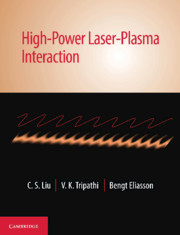Book contents
- Frontmatter
- Dedication
- Contents
- List of Figures
- Preface
- 1 Introduction
- 2 Linear Waves
- 3 Resonance Absorption and Brunel Absorption
- 4 Plasmonics Surface Plasma Waves and Their Coupling to Lasers
- 5 Motion in a Strong Electromagnetic Wave: Ponderomotive Force and Self-Generated Magnetic Field
- 6 Laser Electron Acceleration
- 7 Laser Acceleration of Ions
- 8 Coherent Radiation Emission: Free Electron Laser
- 9 Self-focusing and Filamentation
- 10 Parametric Instabilities
- 11 Parametric Instabilities in Inhomogeneous Plasma
- 12 Nonlinear Schrödinger Equation
- 13 Vlasov and Particle-in-Cell Simulations
- 14 Strong Electromagnetic Field Effects in Plasma
- Index
Preface
Published online by Cambridge University Press: 26 April 2019
- Frontmatter
- Dedication
- Contents
- List of Figures
- Preface
- 1 Introduction
- 2 Linear Waves
- 3 Resonance Absorption and Brunel Absorption
- 4 Plasmonics Surface Plasma Waves and Their Coupling to Lasers
- 5 Motion in a Strong Electromagnetic Wave: Ponderomotive Force and Self-Generated Magnetic Field
- 6 Laser Electron Acceleration
- 7 Laser Acceleration of Ions
- 8 Coherent Radiation Emission: Free Electron Laser
- 9 Self-focusing and Filamentation
- 10 Parametric Instabilities
- 11 Parametric Instabilities in Inhomogeneous Plasma
- 12 Nonlinear Schrödinger Equation
- 13 Vlasov and Particle-in-Cell Simulations
- 14 Strong Electromagnetic Field Effects in Plasma
- Index
Summary
The laser, with its coherent, monochromatic, and well collimated character, has been a most remarkable discovery of the twentieth century. Along with semiconductors, its multifaceted applications have broadly touched and greatly improved our lives – it has made an indelible mark in the field of sensing, printing, barcode scanning, surgery, communications, and so on. It has also become a major tool for scientific research. For example, Thomson scattering and laser induced fluorescence are important tools for plasma diagnostics. Lasers have been used successfully for cooling of atoms and heating of plasmas.
The laser peak power has increased about a 1000 fold every decade since its invention. Starting from hundred watts in the 1960s, table top terawatt Ti: sapphire lasers became available in the 1990s following the discovery of the chirped pulse amplification (CPA) by Mourou and Strickland in 1985. These lasers do not only have high power but also very short pulses of a few femtoseconds, opening a new field of ultra-short pulse lasers and their interactions with matter, such as electron dynamics in molecules. In the past few years, we have seen worldwide efforts to build high power laser infrastructures. The Extreme Light Infrastructure (ELI) has been approved to construct three petawat laser facilities in Eastern Europe. Similar efforts are being made in Korea, Japan and China.
With the rise in laser power, there has been a phenomenal growth in the field of high power laser-plasma interaction with diverse applications, ranging from laser driven fusion and laser acceleration of charged particles to laser ablation of materials. The field has revealed a rich variety of fascinating new phenomena. Parametric coupling between lasers and plasma eigenmodes and quasi-modes gives rise to stimulated Raman, Brillouin, and Compton scattering, two-plasmon decay, and four-wave processes of filamentation, modulational, and oscillating two-stream instabilities of the laser. Nonlinear refraction gives rise to selffocusing and self-guiding of lasers over long distances in plasma and air, offsetting diffraction divergence. Laser interaction with rough metallic surfaces reveals surface-enhanced Raman scattering (SERS) where Raman scattered power from adsorbed molecules rises a million times due to surface plasmon resonance. Laser mode conversion to surface plasma waves (SPWs) on metallic surfaces has been shown to enhance the ablation yield and thin film deposition rates by orders of magnitude, making pulsed laser deposition a very attractive scheme.
- Type
- Chapter
- Information
- High-Power Laser-Plasma Interaction , pp. xix - xxPublisher: Cambridge University PressPrint publication year: 2019



